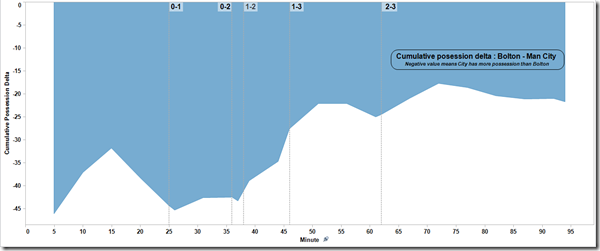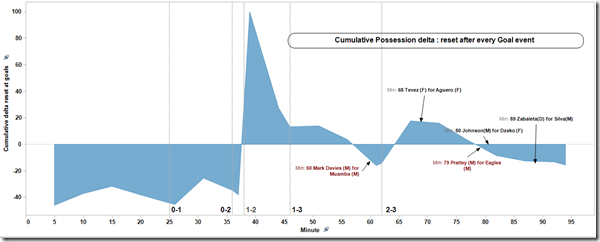This is an “Opposition analysis” of Fulham, City’s opponent on Saturday 29 September at Craven Cottage. I used the #MCFCAnalytics Lite data set to do this analysis.
| Goals | 1.12 per game – 12th (excluding own goals) |
| % of Open play goals | 74.4% – 6th |
| % of goals from inside the box | 86% – 6th |
| % of goals from outside the box | 14% – 15th |
| Shots on Target | 5.13 pg – 7th |
| Efficiency: Goals/shots On + off Target | 11% – 17th |
| Assists per Goals scored | 0.74 – 7th |
| Strong from inside the box | 6st in % of goals from inside the box |
| Weak from outside the box | 15th in % of goals from outside the box |
| Final 3rd completions / comp % | 9th / 8th |
| Short passescompletions / comp % | 8th / 7th |
| Poor at winning corners and scoring from corners | 14th– corners won – 4.92 corners/game18thgoals from corners – 416th Headed goals – 7 |
| Inability to score first | Scored the first goal 13 times. (3rd worst in the league). |
Fulham – Key attacking players
| Goals | Clint Dempsey – 17 Pogrebnyak – 6 Zamora – 5 |
| Shots On Target | Clint Dempsey – 58, Dembélé – 22,Johnson – 16 |
| Efficiency | Pogrebynak – 46.2%Zamora – 21.7%Dempsey – 15.6% |
| Assists | Dempsey – 6 Zamora &Murphy –5 each |
| Final 3rd Completions | Dembélé – 472, Murphy – 461, Dempsey – 416, Duff – 244 |
| Final 3rd Completion% | Dembélé– 84.1%, Duff – 80%, Dempsey – 75.4% Ruiz – 71.2% |
| Touches in opposition box | Dempsey – 150, Zamora – 73, Johnson – 64, Duff – 62 |
| Other interesting aspects | Duff crosses a lot with a very low % of success |
Fulham – Offensive summary
Personnel changes
Fulham has a huge player turnover on the offensive side. The top three players in goals, assists, final third passing and shots in the last season are not with the team anymore.
Clint Dempsey and Moussa Dembélé played a huge part in Fulham’s comfortable 9th place finish. Dempsey scored 17 goals and provided six assists. That accounts for about 50% of all Fulham’s goals. Apart from the goals and assists, he completed 416 passes in the final third (third most in Fulham) and had a team, high 150 touches in the opposition’s 18-yard box.
Dembélé had a big impact in the midfield last season and often was the origin of the attacking moves that ended in a Dempsey shot. He was Fulham’s best passer in the final third with 472 completions at an 84.1% completion rate.
The departure of Danny Murphy along with Dempsey and Dembélé means Fulham has lost all three of its top three passers in the final third. They have added Dimitar Berbatov who could probably make up for the goals of Dempsey. Costa Rican international Bryan Ruiz is likely to feature a lot more in the construction of the attacks. They are off to a fast start so far with three wins in five games tied with Arsenal & City on 9 points. They have also picked up Giorgos Karagounis, who if healthy can be of great value to the team. Hugo Rodallega from Wigan is also a very good pick up. However, questions on who will fill the void left by Murphy and Dembélé remain unanswered.
What the numbers say
Fulham’s attack ran through Dembélé, Murphy and Dempsey. Short passing and shooting from inside the box is the salient feature of Fulham attack. They are poor in shooting efficiency (17th), converting corners (18th) and headed goals (16th). This points to a predominantly ground based attack through the middle. They do not cross a whole lot and Damien Duff who has attempted most open play crosses in Fulham has very poor accuracy. It is likely that opposing teams know that Duff has a propensity to cross the ball and come well prepared to defend them.
Fulham were also very poor at a scoring the first goal (18th) only better than the relegated Bolton & Wolves. This means they are likely a team that is passive in attack and let the opposition take the initiative.
So far this season
Berbatov, Duff, Ruiz have had fast starts to their season. Fulham have scored the most goals (12) and have the fifth best pass completion rate in the league so far this season. Better numbers than City in both categories. Apart from Manchester United away, they have not played any big teams yet. They are unbeaten at home and this could be a big test for both Fulham and City.
Fulham – Defence
| Goals conceded | 1.29/game – 8th lowest |
| Final 3rd passes completions allowed | 101.1/game 5th highest |
| Opponents Final 3rd pass completion % | 68.94% – 2nd highest |
| Successful open play crosses allowed | 4.08/game – 4th highest |
| Shots on Target Conceded | 3rd highest2nd highest – From outside the box |
| Tackles | Win 77% of their tackles – 3rd most18st in last man tackles |
| Fouls committed | 9.9/game – 4th fewest |
| Other aspects | Allowed the opposition to score first in 22 games (5th most) |
Fulham – Defensive summary
The numbers from last year indicate that Fulham tends to defend deep and allows opponents a lot completions and possession in their defensive third. They also concede a high number of shots conceded from outside the box. This is a sign of passive defending. They do not seem to close down quickly enough to avoid good shots from outside the box. When they tackle, they tend to tackle cleanly and win a high percentage of them. They also allow a high number of successful open play crosses. Since crossing is inherently has a low percentage of success, this is another sign that Fulham defenders do not close down quickly. They commit very few fouls and do not concede many corners. All in all a defence, which is not aggressive, “lets you play” and tackle clean cleanly.
Fulham allowed their opponents score the first goal 22 times (5th most) as opposed to scoring only 13 themselves (third lowest total). Another indicator of the recurring theme of passiveness in their play.
Fulham – Goalkeeping – Mark Schwarzer
| Goals conceded overall | 1.23/game – 10th fewest |
| Saves made | 11th most |
| GK distribution efficiency(Successful GK distribution/Total GK distribution) | 3nd best – 72% |
| Long passes completion | 34% – 3rd lowest |
| Short passes completion rate | 95.2% – 5th best |
| Ratio of Long to short passes | 70-30 |
Fulham – Goalkeeping Summary
Mark Schwarzer has very high distribution efficiency. He is also very good at short passes. Schwarzer has a propensity to punch the ball than any other keeper in the Premier League (among keepers who started at least 20 games). He is also the second highest in the league in catches/game & sixth highest in saves per game.
These stats correlate to the high number of shots on target allowed by Fulham’s defence. Schwarzer’s good goalkeeping is one of the reasons why Fulham did not concede many more goals.
City vs. Fulham Head – to – head 2011-12
§ Fulham came back from 0-2 down to draw 2-2 at the craven cottage. Aguero scored twice for City. Zamora and Kompany’s own goal tied it for Fulham.
§ City easily won 3-0 at the Etihad. Aguero, Dzeko & Chris Baird – own goal were the scorers.
§ City had more final 3rd completions (139. Season average 135) away from home than at home.
§ Fulham had a better final third completion percentage away from home than at home.
Final word
Fulham have played well and have scored a league-high 12 goals so far despite so many new faces in their attack. City will have their hands full defending the likes of Berbatov, Ruiz and Duff. City has not had a clean sheet so far this season. Will there be a lot of goals in this one?
To win City needs to:
§ Control Ruiz and Duff’s influence would be key to win this game. Berbatov is probably more talented than Dempsey but Fulham’s midfield is not as strong as it was last season.
§ Take advantage of the passivity of the Fulham defence. They allow a lot of possession to their opponents in their defensive third and allow opponents to take many shots on target.
§ Be aggressive and take the lead. Fulham has let opponents score the first goal 22 times last season. City has a great record when they score first (25 W, 2 D & 1 L last season).






